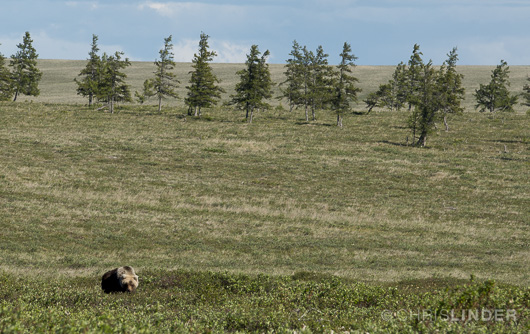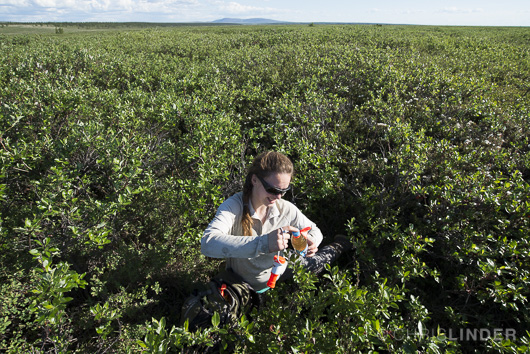I thought I knew what I wanted to study, and how to do it. I needed water—a stream that ran from headwaters down through beaded pools and into an outlet. There were many of them around Cherskiy, but there were none near our mooring on the Kolyma River.
So I went looking for water—a stream with a real channel which we could see on the satellite image of the area. Sergey and Nikita Zimov, the father and son team who run the Northeast Science Station, took another student, myself, and three of what we 20-somethings call “the adults” out in two skiffs to find it.
I thought we were just scouting the area, not collecting any samples. But as the first channel kept going further, winding crazily with bushes on either side and looking like the river in African Queen, I started getting nervous. Were we wasting time because of me? We could not easily return—the distances I had been picturing were much smaller than the distances I was experiencing. When we got out of the boat, we saw a big brown bear scratching its back against a lone larch tree—one of the last trees before the boreal forest gives way to the treeless tundra. It raised its massive head and stared straight at us. After a few heartbeats, it tore away, bounding as far as we could see, on and on away from us back to the forest. Away from us. So that was nice. At least the others had seen something worth the trip, but as the bear left my thoughts turned back to my project.

Bear on the Tundra.
Julian encouraged me to take a sample, since it was unlikely we’d get back. We had only plastic water bottles, which we thoroughly rinsed and used. As I filled my bottles with tea-colored water from these streams, I tried to connect these samples to what I wanted to know. On the ride up the next stream (made longer by intermittent repairs to the outboard engine), I began scribbling in my notebook. By the time we startled a large male moose out of the stream and up onto the bank, I had adjusted my plan. I wanted to know how large, stable carbon compounds were breaking down on their way from land and ocean, didn’t I? So I would look at a variety of water paths and determine how light and biology were contributing to breakdown in each case. Instead of trying to leave experiments in jars in the actual streams and thus need to retrace all of my circuitous tracks, I would bring my experiments back to the barge.

Taking a water sample from a stream hidden by willows.
I no longer feared that I had wasted the expedition. I had a more realistic plan, based on observation rather than imagination. The samples I retrieved would be useful, and however much my research design continued to change, I had learned an important lesson. I will never again leave for an outing without sample bottles.




Comment(1)-
Larri Spengler says
July 12, 2014 at 5:13 pmGerry Durrell and Theodore would so highly approve of your final sentence!